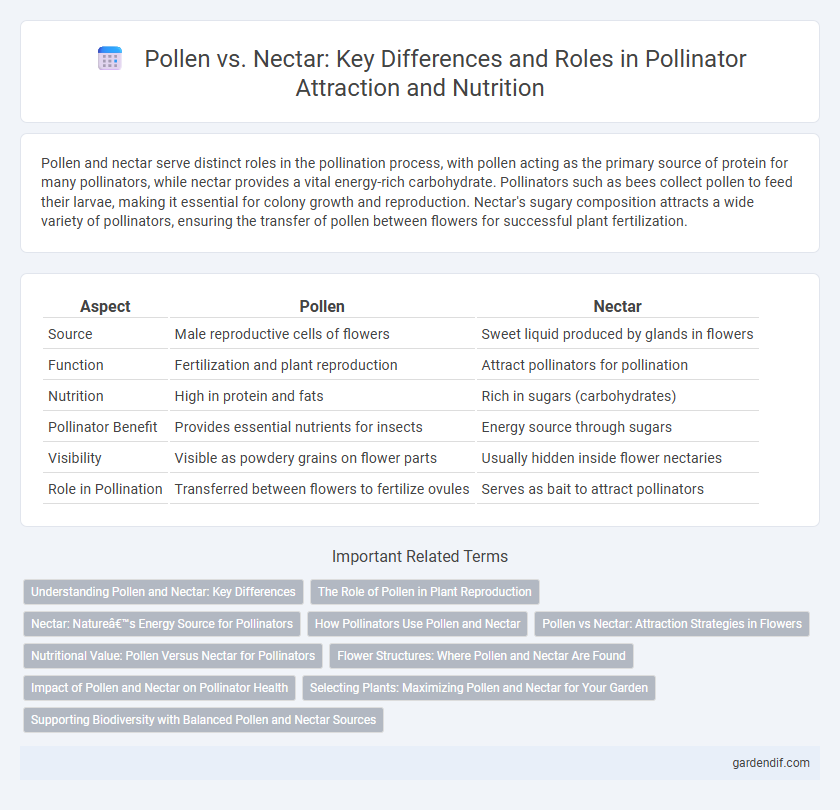
Pollen vs Nectar Illustration
Pollen and nectar serve distinct roles in the pollination process, with pollen acting as the primary source of protein for many pollinators, while nectar provides a vital energy-rich carbohydrate. Pollinators such as bees collect pollen to feed their larvae, making it essential for colony growth and reproduction. Nectar's sugary composition attracts a wide variety of pollinators, ensuring the transfer of pollen between flowers for successful plant fertilization.
Table of Comparison
| Aspect | Pollen | Nectar |
|---|---|---|
| Source | Male reproductive cells of flowers | Sweet liquid produced by glands in flowers |
| Function | Fertilization and plant reproduction | Attract pollinators for pollination |
| Nutrition | High in protein and fats | Rich in sugars (carbohydrates) |
| Pollinator Benefit | Provides essential nutrients for insects | Energy source through sugars |
| Visibility | Visible as powdery grains on flower parts | Usually hidden inside flower nectaries |
| Role in Pollination | Transferred between flowers to fertilize ovules | Serves as bait to attract pollinators |
Understanding Pollen and Nectar: Key Differences
Pollen and nectar serve distinct functions in pollination, with pollen acting as the male reproductive cells essential for fertilizing plants, while nectar is a sugary liquid that attracts pollinators like bees and butterflies. Pollen contains proteins, lipids, and vitamins that are vital for the nutrition of many pollinators, whereas nectar primarily provides an energy-rich carbohydrate source. Understanding these key differences helps optimize pollination strategies and supports the health of pollinator populations.
The Role of Pollen in Plant Reproduction
Pollen serves as the primary carrier of male gametes necessary for fertilization in plant reproduction, enabling the transfer of genetic material between flowers. Unlike nectar, which attracts pollinators by providing a food reward, pollen directly contributes to the creation of seeds and fruit by facilitating the fertilization process. Effective pollen transfer by insects, birds, or wind ensures genetic diversity and successful plant reproduction cycles.
Nectar: Nature’s Energy Source for Pollinators
Nectar serves as the primary energy source for pollinators, providing essential sugars that fuel their flight and daily activities. Unlike pollen, which mainly supplies proteins and nutrients necessary for reproduction, nectar's high concentration of glucose, fructose, and sucrose offers immediate energy boosts. This sweet liquid plays a crucial role in supporting the metabolic needs of bees, butterflies, hummingbirds, and other pollinators, ensuring ecosystem pollination and biodiversity.
How Pollinators Use Pollen and Nectar
Pollinators collect pollen primarily as a protein-rich food source essential for larval development, while nectar provides a high-energy carbohydrate supply necessary for adult pollinator metabolism and flight. Bees, butterflies, and hummingbirds utilize specialized body parts to gather and transport pollen, facilitating plant fertilization, whereas nectar is accessed through probing flowers with elongated mouthparts or tongues. The dual collection of pollen and nectar not only sustains pollinator populations but also enhances cross-pollination, increasing biodiversity and crop productivity.
Pollen vs Nectar: Attraction Strategies in Flowers
Pollen and nectar serve distinct attraction strategies in flowers to lure pollinators, with pollen offering protein-rich food primarily to bees, while nectar provides sugary energy that attracts a broader range of insects and birds. Flowers often evolve specific traits to enhance the visibility or accessibility of pollen or nectar, such as bright colors for nectar guides or powdery pollen grains easily collected by pollinators. Understanding how pollen versus nectar functions in floral attraction reveals the diverse ecological interactions that drive pollination efficiency and plant reproduction.
Nutritional Value: Pollen Versus Nectar for Pollinators
Pollen provides pollinators with essential proteins, lipids, vitamins, and minerals necessary for growth and reproduction, making it a crucial nutrient source. Nectar primarily offers carbohydrates in the form of sugars, supplying immediate energy for flight and daily activities. The combination of pollen and nectar supports a balanced diet, but pollen's richer nutritional profile makes it indispensable for the development of larvae and the overall health of pollinator populations.
Flower Structures: Where Pollen and Nectar Are Found
Pollen is typically located on the anthers, the male reproductive parts of a flower, designed to facilitate transfer by pollinators. Nectar is produced in nectar glands, often found at the base of petals or within floral tubes, attracting pollinators with its sugary reward. The distinct placement of pollen and nectar within flower structures optimizes pollination efficiency by guiding pollinators to both reproductive parts and food sources.
Impact of Pollen and Nectar on Pollinator Health
Pollen supplies essential proteins and lipids vital for the growth and reproduction of pollinators, significantly influencing their immune function and longevity. Nectar provides a primary source of carbohydrates, fueling pollinators' energy demands for foraging and flight activities. Balanced access to high-quality pollen and nectar is crucial for sustaining robust pollinator populations and enhancing their resistance to environmental stressors and pathogens.
Selecting Plants: Maximizing Pollen and Nectar for Your Garden
Selecting plants rich in both pollen and nectar is crucial for supporting diverse pollinators like bees, butterflies, and hummingbirds. Favor native species such as coneflowers, bee balm, and goldenrod to provide abundant resources throughout the growing season. Incorporate a variety of flower shapes and bloom times to maximize pollen and nectar availability, enhancing your garden's ecological health and pollinator attraction.
Supporting Biodiversity with Balanced Pollen and Nectar Sources
Balanced pollen and nectar sources are crucial for supporting biodiversity by providing essential nutrients to a wide range of pollinators, including bees, butterflies, and hummingbirds. Diverse plant species offering varied pollen protein and nectar sugar concentrations enhance pollinator health and resilience, promoting ecosystem stability. Ensuring habitats include plants with overlapping bloom times guarantees continuous availability of these resources, sustaining pollinator populations and overall biodiversity.
Pollen vs Nectar Infographic

 gardendif.com
gardendif.com